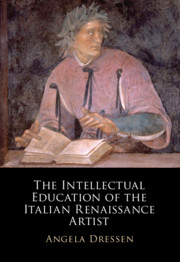Book contents
- The Intellectual Education of the Italian Renaissance Artist
- The Intellectual Education of the Italian Renaissance Artist
- Copyright page
- Contents
- Illustrations
- Preface
- Introduction
- One Mechanical Arts versus Liberal Arts and Recommendations for the Artist’s Education
- Two Educational Places and Opportunities
- Three The Mediating Texts
- Four Vitruvius and Pliny as Sourcebooks, Educational Landmarks, and Intellectual Challenge
- Conclusion
- Book part
- Selected Bibliography
- Index
Four - Vitruvius and Pliny as Sourcebooks, Educational Landmarks, and Intellectual Challenge
Published online by Cambridge University Press: 28 August 2021
- The Intellectual Education of the Italian Renaissance Artist
- The Intellectual Education of the Italian Renaissance Artist
- Copyright page
- Contents
- Illustrations
- Preface
- Introduction
- One Mechanical Arts versus Liberal Arts and Recommendations for the Artist’s Education
- Two Educational Places and Opportunities
- Three The Mediating Texts
- Four Vitruvius and Pliny as Sourcebooks, Educational Landmarks, and Intellectual Challenge
- Conclusion
- Book part
- Selected Bibliography
- Index
Summary
Pliny (Natural History) and Vitruvius (De architectura) were the only important sources on ancient art and architecture available in the Renaissance, and both texts had an enormous impact on artists and patrons.1 For a Renaissance artist in need of information on ancient art and architecture, including materials, techniques, and topics, it was highly desirable to get access to these sources. The two sources offered different insights: while Vitruvius dealt predominantly with architecture, Pliny offered a view into all three visual arts in antiquity in his encyclopedic work. With Pliny we have not only a first introduction to art but also a first historical overview, including the evolution of art and artists. Furthermore, both texts were the first important and highly influential sources on the education of artists. Although Pliny himself benefited from Vitruvius’s art theory, as well as from the visual evidence around him, he also relied on other important sources on art and architecture like Varro and others. Despite Pliny’s text receiving a print run and vernacular translation earlier than Vitruvius’s, Pliny’s text did not inspire substantial commentaries as Vitruvius’s did. Rather, it was read as a sourcebook. In spite of its importance, the work of Pliny will not be treated here with the respect it deserves, as readers are referred to two recent and comprehensive studies.2 Nevertheless, a short summary will be valuable to complete the picture of important literature available for the artist. While Vitruvius’s text functioned likewise as an important sourcebook, it also took part in the intellectual challenge of making literary commentaries. For the first time, artists participated on an almost equal level in translating and commenting, thus indicating how much the visual arts were both taking part in the liberal arts and also competing with them. After summarizing the translation history on Vitruvius, the focus will then turn to evaluating the new commentary tradition on Vitruvius’s text, which has so far received very limited attention.
- Type
- Chapter
- Information
- The Intellectual Education of the Italian Renaissance Artist , pp. 283 - 321Publisher: Cambridge University PressPrint publication year: 2021



